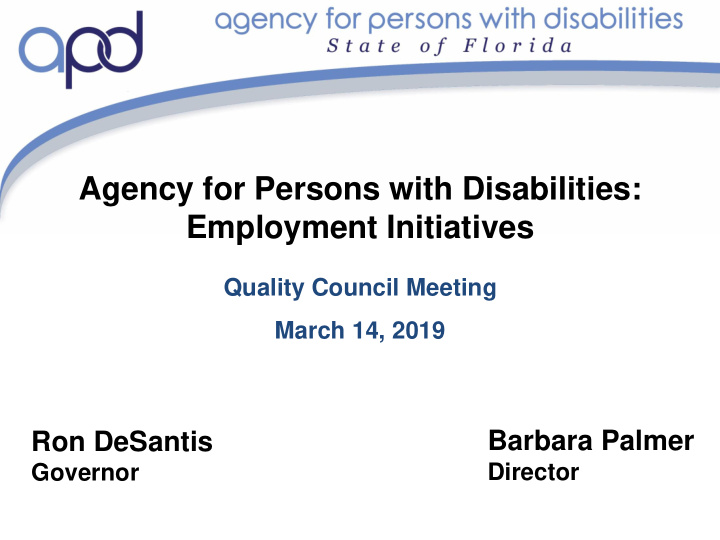



Agency for Persons with Disabilities: Employment Initiatives Quality Council Meeting March 14, 2019 Barbara Palmer Ron DeSantis Director Governor
Why is Employment so Important? “I really want to live in a world where disability is not the exception but the norm” Stella Young 2 2
How Can an Individual Succeed? Each individual has unique interests, strengths, and challenges On-the-job accommodations vary by person “Success” means a win -win outcome for both the individual and employer Common variables that lead to success: Self-advocacy and awareness Education and training opportunities First-hand experiences A collaborative support system APD works with state/community partners to promote these variables for individuals with intellectual/developmental disabilities (IDD) 3 3
What Support Options are Available? Pre-Employment Education (VR/School System) Career exploration, work-based learning experiences, self-advocacy training, peer mentoring, etc. Vocational Rehabilitation (VR) Skills assessment, on-the-job training, assistive technology, post-secondary training, etc. Supported Employment (VR/APD) Intensive job development, on-going job coaching, customized employment, benefits planning, etc. Adult Day Training (APD) Facility- based “sheltered” workshops, group -based work enclaves/mobile crews, life skills training, etc. 4 4
What is VR? Federal-state program administered within the Department of Education For individuals who present barriers to employment due to disability Collaborates with APD and others to fund Supported Employment (SE) services for individuals with most significant disabilities in 2 phases: Phase 1 – VR funds Intensive, time-limited support to obtain employment Phase 2 – APD (or other entity) funds on- going support after “job stabilization” VR Outcomes in FY 2017-18 7,680 (21%) of VR customers received SE services $23,781,758 (24%) of VR funds spent on SE services 4,617 of SE recipients have an IDD 4,752 of VR customers obtained or kept employment 908 (19%) of employed VR customers have an IDD 5 5
What is the State of the State? Florida’s leaders have worked to increase employment outcomes: The Florida Employment First Act of 2016 The Employment Enhancement Program (EEP) for individuals on the APD waiting list Employer outreach initiatives, such as the “Abilities Work” Help Desk Other collaborative efforts, such as Career Counseling and Information Referral (CCIR) for individuals in subminimum wage employment APD Waiver and Waiting List Individuals Competitively Employed 3,500 2,905 2,835 3,000 2,528 2,500 2,099 1,751 2,000 1,500 846 1,000 659 First year of EEP Funding 500 0 FY 2011-12 FY 2012-13 FY 2013-14 FY 2014-15 FY 2015-16 FY 2016-17 FY 2017-18 6
The National and State Disparity Percent Employed Percent Below Poverty 80 35 73.6 32 72.7 29.7 70 30 26.8 26 60 25 50 20 40 34.3 31.9 15 13 12.4 30 24.8 20.6 10 20 5 10 0 0 No Disability Any Disability Cognitive Disability No Disability Any Disability Cognitive Disability United States Florida United States Florida American Community Survey, 2016 7
Barriers Contributing to the Disparity Floridians with Disabilities Myths and misperceptions of the Receiving SSI Benefits in 2016 “limitations” of working with a disability Total Recipients 439,184 Total Employed 12,673 Fear of losing health benefits from Percent Employed 2.6% public assistance programs due to income and resource limits Total Receiving an 338 SSI Work Incentive Percent Receiving an Historic trend of employment not <0.01% SSI Work Incentive being a priority within the disability service systems Social Security Administration, “SSI 41% of adults served by APD want to work Disabled Recipients Who Work” in their community, but only 19% have employment as a goal on their service plan (National Core Indicators Survey, 2016) 8 8
APD Employment and Day Services 25,000 18,516 18,510 20,000 17,194 16,717 15,178 14,316 15,000 10,000 5,000 2,465 2,337 2,416 2,372 2,149 2,236 0 2012 2013 2014 2015 2016 2017 Supported Employment Facility-Based and Other Day Services Institute for Community Inclusion (ICI), UMass- Boston, “The National Survey of IDD Agencies’ Day and Employment Services,” 2017 9
iBudget Expenditures on Life Skills Development Fiscal Year 2017-18 $90,000,000.00 $85,289,888.10 $80,000,000.00 $70,000,000.00 $60,000,000.00 $50,000,000.00 $40,415,827.97 $40,000,000.00 $30,000,000.00 $20,000,000.00 $10,000,000.00 $5,186,638.46 $0.00 Facility-Based Adult Day Companion Care Supported Employment Training (ADT) (SE) 10
Breakdown of iBudget Expenditures in Life Skills Activities in FY17-18 Spend in Spend in All Life Skills Participant Spend in SE ADT Facility Life Skills Average Billable Hours 1041.61 80.85 Average Spend in ALL Life Skills Activities $6,441.35 $3,001.53 $7,161.84 Average Spend if in BOTH ADT and SE $3,291.92 $2,473.35 $6,479.15 Average Spend if NOT in SE $6,508.15 $6,987.75 Average Spend if NOT in ADT $3,101.49 $3,798.68 11
Variables Contributing to Successful Employment Outcomes Analysis of iBudget data found multiple variables contributing (positively or negatively) to whether an individual is competitively employed: Geographic Region – Individuals living in certain regions, such as Northwest, have a higher probability of success Living Setting – Individuals receiving Supported Living or IL have a higher probability QSI Scores – Individuals with lower physical scores have a higher probability Adult Day Training – Individuals in a facility have a lower probability Service Plan Amount – Individuals with a higher amount have a lower probability Age – Individuals who are older have a higher probability until peaking at 44, then a lower probability each subsequent year 12
NEXT STEPS… 13
How Are We Addressing these Challenges? Educating state leaders about the importance of employment for individuals with IDD Improving collaboration with VR to support individuals in ADT settings who want to work VR served 4,780 through CCIR training for those in subminimum wage jobs in FY 2016-17 Working with national experts to identify improvements in iBudget SE/ADT services Engaging stakeholders to develop strategies that will improve employment outcomes Providing training and technical assistance to APD staff to address barriers and gaps 14 14
Questions? For More Information, Contact David Darm at: David.Darm@apdcares.org 15 15
Recommend
More recommend